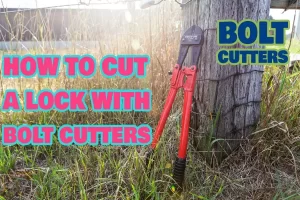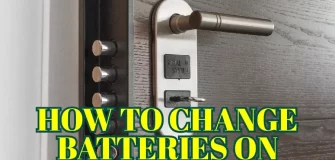How To Cut A Lock With Bolt Cutters- A Step-By-Step Guide
Share
Locks are meant to secure our property. Locks are designed to protect and keep people with ill intentions away. The problem with locks is that things get tricky when you lose your keys.
There are several techniques that you can use to break locks. Picking locks is quite difficult. It requires a special technique that can be difficult to perfect.
Hiring a locksmith is a viable option. These professionals can help you open locks with very little damage.
Hiring a locksmith can be costly. Some locks aren’t that expensive and are easy to replace. You can use bolt cutters to open such locks.
Bolt cutters are efficient. They require less effort than using hacksaws. They are also safer and faster.
How To Cut A Lock With Bolt Cutters
Using bolt cutters is an effective way of breaking a lock. Bolt cutters are easy to find. They are also quite safe to use. What do you need to get started?
- A pair of 24-inch bolt cutters
Ideally, you want to use a long pair of bolt cutters. Long cutters are safer and offer better protection against shrapnel.
- A pair of safety goggles
Safety goggles are a requirement. When cutting locks, the ensuing projectile has an unpredictable path. Googles will prevent shrapnel from hitting your eyes.
- A pair of safety gloves
They are meant to protect your hands from projectile as you cut the lock.
Once you have the necessary materials, let’s get cutting:
Step 1: Position the bolt cutters blades on the shackles of the padlock
The shackle is the arched part of the lock. You can put pressure on the lock by pressing it against the wall or gate to prevent it from moving around as you attempt the cut.
It would help if you held the handles closer to the edge as it is the most efficient cutting method. It is also safer.
Step 2: Squeeze the handles
Compress the handles until the lock breaks. For padlocks made from harder materials, you will need to use a lot of force. Bolt cutters only work on small locks. They may not work on hardened steel locks.
Other Lock Breaking Methods
There are several other techniques that you can use aside from using bolt cutters. These techniques vary in success.
Bolt cutters aren’t perfect either, as they are only useful against small padlocks. They also can’t break through stainless steel.
If bolt cutters fail, you can use these other methods:
Sawing Off The Lock
Sawing is a great method in the absence of bolt cutters. It is also relatively effective against steel padlocks. Sawing requires patience as it takes time and a lot of effort. Here is what you need to saw off a padlock.
Equipment:
- Blow torch:
You require a blowtorch to soften the steel as it makes it easier to cut the padlock.
- Vise-grip:
A vise-grip helps you hold the padlock safely as you use the blow torch.
- Hacksaw:
It would help if you had a hacksaw to cut the padlock.
- Padded safety gloves:
It would help if you had a pair of safety gloves for additional protection against the heat from the blow torch.
Procedure:
Step 1: Attach the vise-grip
Fix the vise-grip to the bottom of the lock. Secure it tightly, so it does not move around during cutting.
Step 2: heat the shackle.
Hold the padlock using the vise-grip at the bottom. Use the blowtorch to blast a steady stream of heat to the shackle. It will raise the temperature significantly. Heating the shackle softens the metal and makes it easier to cut.
Step 3: Cut the shackle:
Using the hacksaw, cut the heated section of the shackle. Until the blade goes clean through, you may need to reheat the shackle in the middle of the cut, depending on the shackle’s thickness. It would help if you never used a blunt blade when cutting locks or other metallic materials.
Use Two Wrenches
You can use a pair of wrenches to break a lock. The technique works best when trying to break small locks.
It requires a lot of effort and may not be effective against hardened steel padlocks. You will need the following materials:
- A couple of wrenches
You will need two wrenches, preferably of the same size. The wrench jaws should fit inside the shackle’s arch.
- Safety gloves
It would be best to have safety gloves for additional protection against fragments.
- Face shield
It will protect your face from projectile when the shackle snaps.
Procedure:
Step 1: Insert the wrench hooks in the shackles
The wrench jaws should make contact with each other. The intention is to position them, so they are side by side while making contact with each other and the shackle.
Step 2: Hold the wrench handles firmly on the edges
It would help if you held the handles safely near the bottom of the handle. The padded safety gloves will protect your fingers.
Step 3. Squeeze the handles toward each other
Try and break the shackle by squeezing the wrench handles toward each other. It would help if you were patient, as some locks can be really hard to break.
Try compressing the shackle towards the middle, as that is the weakest point. Use as much force as you can.
Step 4: Twist and release the shackle
Once you break the shackle, you can release the lock.
Using Compressed Air
Compressed air is perfect for small locks and has moderate success breaking larger locks. It is a fast and easy way to burst open a stubborn lock. You can purchase compressed air at a hardware store, as they are sold in cans.
What do you need?
- A can of compressed air
Pick cans that specifically have a high difluoroethane concentration as they will make the lock easier to break.
- A hummer
You will need it to force the lock open.
- Safety gloves
They will protect your skin from difluoroethane.
- Face shield
It will protect your face from metallic shrapnel.
Procedure
Step 1: Spray the lock
Concentrate a jet of air at the base of the lock. You can spray the lock at the base of the shackle. You will notice a bit of frosting developing at that point—the frosting results from the difluoroethane. Spray for 45 seconds to 1 minute.
Step 2: Strike the frosted bit
Using the hammer, hit the frosted bit continuously using force until the metal shatters. You may need to use more compressed air if you do not succeed on your first try.
Using a Grinding Tool
A grinding tool is perfect as it works well on any lock. They make light work of hardened steel padlocks and work properly on big locks. Here is a list of items that you will need to get started:
- Portable grinder
You will need a portable grinder as they are easier to manipulate.
- A 1.2 mm grit disc
It is the cutting edge that sinks into the lock’s shackle
- Face shield
A safety shield will protect your face from shrapnel.
- A vice-grip
It will enable you to hold the vice-grip safely as you cut.
Procedure
Step 1: Attach the 1.2 mm grit disc to the portable grinder
Ensure the disk is secure to prevent it from inadvertently flying off as you cut, as it could result in serious injuries.
Step 2: Plug the portable grinder into a power source
You will need to be near an outlet to power the grinder. A portable grinder should have a long extension cord.
Step 3: Clasp the lock
Secure the base of the lock with a vice-grip. Attach the vice-grip firmly, so it does not move about as you cut the lock.
Step 4: Cut the lock
Turn on the grinder. Angle the cut so that the blade strikes the shackle. An upward cut is preferable, as the sparks shoot off away from your hand. Maintain pressure on the lock until the blade goes clean through.
Step 5: Twist the lock to release
Please do not touch the lock, as it is still very hot.
Hire A Professional
Some locks have been designed to withstand impact. You may also not have the required cutting tools to slice through the locks.
All the techniques described above carry with them risks. It may be ill-advised to try and break a lock if you lack the proper safety equipment.
A professional locksmith will open these locks with ease, as they have the expertise and experience of dealing with locks.
Conclusion
Breaking locks are relatively easy, depending on the type and quality of the lock. Some locks are easier to break than others. The hardest locks to break are those that are forged from hardened steel.
There are several lock-breaking techniques. The most important thing to remember when attempting to break a lock is safety. Using bolt cutters is one of the safest methods of breaking locks. It requires little effort and is pretty efficient.
The article summarizes the key techniques and safety guidelines you should follow when cutting or breaking a lock.

















